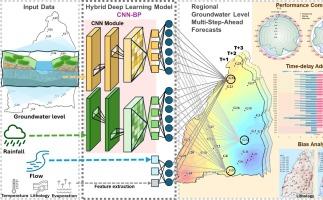基于混合深度学习模型的先进地下水位预测:解决台湾最大冲积扇的水挑战
IF 6.3
1区 地球科学
Q1 ENGINEERING, CIVIL
引用次数: 0
摘要
地下水对粮食安全和经济发展至关重要,但它面临着过度开采和极端天气事件日益严重的威胁。卓水河冲积扇是台湾最大的冲积扇,长期以来一直是重要的水源。然而,近年来的气候变化和工业扩张严重影响了地下水的补给和质量,导致了地面沉降。准确预测地下水位对确保该地区环境的可持续性至关重要。基于卷积神经网络(CNN)和反向传播神经网络(BPNN)相结合的混合深度学习模型CNN- bp,对卓水河冲积扇25个监测站的地下水水位进行了3天前的预测。CNN-BP模型与独立的BPNN模型进行基准测试。这两个模型都是在2000年至2019年7291条每日水文地质气象记录的数据集上进行训练的,包括地下水位、降雨量、河流流量、温度、蒸发和岩性。本研究强调综合输入选择、特征提取和超参数整定,利用随机森林对20个雨量站的输入因子进行过滤,提高了预测的准确性和可靠性。CNN-BP模型明显优于BPNN模型,在不同的台站中实现了0.94到0.98之间的R2值,有效地缓解了时延问题。该研究还探讨了预测误差与扇体岩性特征之间的关系,为土地利用规划和地下水管理提供了有价值的见解。台风海棠和玛丽亚的验证进一步证明了该模型在强降雨条件下预测地下水补给的能力。通过综合干旱频率、人口密度和补给潜力等环境和社会因素,本研究强调了有针对性的水资源管理战略的必要性。这些发现为未来的区域地下水管理方法提供了重要的见解,促进了跨流域的可持续实践。最终,该研究为土地利用规划和水资源管理的明智决策提供了宝贵的资源,促进了涿水河冲积扇地下水的可持续利用。本文章由计算机程序翻译,如有差异,请以英文原文为准。

Advanced groundwater level forecasting with hybrid deep learning model: Tackling water challenges in Taiwan’s largest alluvial fan
Groundwater is crucial for food security and economic development, yet it faces growing threats from over-extraction and extreme weather events. The Zhuoshui River alluvial fan, Taiwan’s largest, has long served as a key water source. However, recent climate change and industrial expansion have significantly affected groundwater recharge and quality, contributing to land subsidence. Accurate forecasting of groundwater levels is essential to ensuring environmental sustainability in the region. This study presents a novel hybrid deep learning model, CNN-BP, which integrates Convolutional Neural Networks (CNN) with Backpropagation Neural Networks (BPNN) to forecast groundwater levels three days in advance at 25 monitoring stations across the Zhuoshui River alluvial fan. The CNN-BP model was benchmarked against a standalone BPNN model. Both models were trained on a dataset of 7,291 daily hydro-geo-meteorological records from 2000 to 2019, including groundwater levels, rainfall, streamflow, temperature, evaporation, and lithology. The study emphasizes comprehensive input selection, feature extraction, and hyperparameter tuning, with Random Forest utilized to filter input factors from 20 rainfall stations, thereby improving forecast accuracy and reliability. The CNN-BP model significantly outperformed the BPNN model, achieving R2 values between 0.94 and 0.98 across various stations and effectively mitigating time-delay issues. The study also explored the relationship between forecast errors and the fan’s lithological characteristics, providing valuable insights for land-use planning and groundwater management. Validation during Typhoons Haitang and Maria further demonstrated the model’s capability to predict groundwater recharge under intense rainfall conditions. By integrating environmental and social factors such as drought frequency, population density, and recharge potential, this study underscores the need for targeted water management strategies. The findings offer critical insights for future regional approaches to groundwater management, promoting sustainable practices across watersheds. Ultimately, this study serves as a valuable resource for informed decision-making in land-use planning and water resource management, advancing the sustainable utilization of groundwater in the Zhuoshui River alluvial fan.
求助全文
通过发布文献求助,成功后即可免费获取论文全文。
去求助
来源期刊

Journal of Hydrology
地学-地球科学综合
CiteScore
11.00
自引率
12.50%
发文量
1309
审稿时长
7.5 months
期刊介绍:
The Journal of Hydrology publishes original research papers and comprehensive reviews in all the subfields of the hydrological sciences including water based management and policy issues that impact on economics and society. These comprise, but are not limited to the physical, chemical, biogeochemical, stochastic and systems aspects of surface and groundwater hydrology, hydrometeorology and hydrogeology. Relevant topics incorporating the insights and methodologies of disciplines such as climatology, water resource systems, hydraulics, agrohydrology, geomorphology, soil science, instrumentation and remote sensing, civil and environmental engineering are included. Social science perspectives on hydrological problems such as resource and ecological economics, environmental sociology, psychology and behavioural science, management and policy analysis are also invited. Multi-and interdisciplinary analyses of hydrological problems are within scope. The science published in the Journal of Hydrology is relevant to catchment scales rather than exclusively to a local scale or site.
 求助内容:
求助内容: 应助结果提醒方式:
应助结果提醒方式:


